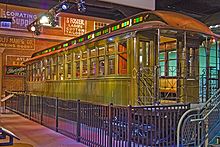- Multiple-unit train control
-
Multiple-unit train control, sometimes abbreviated to multiple-unit or MU, is a method of simultaneously controlling all the traction equipment in a train from a single location, whether it is a Multiple unit comprising a number of self-powered passenger cars or a set of locomotives.
A set of vehicles under multiple unit control is referred to as a consist in the United States[1].
Contents
Origins
Multiple-unit train control was first used in Electric Multiple Units in the 1890s.
Frank J. Sprague
The multiple unit traction control system was pioneered by Frank Sprague and first applied and tested on the South Side Elevated Railroad (now part of the Chicago 'L') in 1897.
In 1895, derived from his company's invention and production of direct current elevator control systems, Frank Sprague invented a multiple unit controller for electric train operation. This accelerated the construction of electric traction railways and trolley systems world wide.
Each car of the train has its own traction motors: by means of motor control relays in each car energized by train-line wires from the front car all of the traction motors in the train are controlled in unison.
The Liverpool Overhead Railway
The Liverpool Overhead Railway, which opened in 1893, was also an early user of electric multiple-unit trains.[2] It is not clear, however, if these used a system of multiple-unit train control before Sprague's invention; in their initial two-car formation, the rear motor coach may merely have been towed.
Locomotive applications
Sprague's MU system was adopted for use by diesel-electric locomotives and electric locomotives in the 1920s, however these early control connections were entirely pneumatic. Today's modern MU control utilizes both pneumatic elements for brake control, and electric elements for throttle setting, dynamic braking and fault lights.
In the early days of diesel electric MUing there were numerous different systems and while some were compatible with one and other, some were not. For example when first delivered many F units lacked MU cables on their noses, allowing only for MUing through the rear of the locomotive. That meant that if a train need four locomotives and there were four A units and no B units that a train would require two train crews as the four A units could not be multiple unit controlled, except as two groups of two. Furthermore Baldwin Centipedes were infamous for being unable to MU with any other locomotive even other Baldwin diesels, these locomotives could only be MUed with one other locomotive of the same type.
Terms used in North America are A unit and B unit where the B or "slave" unit does not have a control cab; slug where the B unit has traction motors powered by the "mother" unit via extra connections; and Cow-calf for switcher units. A Control Car Remote Control Locomotive has remote control but not traction equipment.
Most modern diesel locomotives are now delivered equipped for MU operation, allowing a consist (set) of locomotives to be operated from one cab. However, not all MU connections are standardized between manufacturers, thus limiting the types of locomotives that can be used together. In North America there is a high level of standardization using the Association of American Railroads (AAR) system.[3] In the United Kingdom several different incompatible MU systems are in use (and some locomotive classes were never fitted for MU working), but more modern diesel locomotives used on British railways use the standard AAR system.
Modern locomotive MU systems can be easily spotted due to the large MU cables to the right and left of the coupler. The connections typically consist of several air hoses for controlling the air brake system, and an electrical cable for the control of the traction equipment. The largest hose, located next to the coupler is the main air brake line or "train line". Additional hoses link the air compressors on the locomotives and control the brakes on the locomotives independently of the rest of the train. There are sometimes additional hoses that control the application of sand to the rails.
With distributed power, long trains e.g. ore trains on mining lines may have locomotives at each end and at intermediate locations in the train to reduce the maximum drawbar load. The locomotives are often radio controlled from the lead locomotive by the Locotrol system. Remote control locomotives e.g. "switchers" in hump yards may be controlled by a stationary operator.
Passenger train applications
Modern electric multiple unit and diesel multiple unit vehicles often utilise a specialised coupler that provides both mechanical, electrical and pneumatic connections between vehicles. These couplers permit trains to be connected and disconnected automatically without the need for human intervention on the ground.
There are a few designs of fully automatic couplers in use worldwide, including the Scharfenberg coupler, various knuckle hybrids (such as the Tightlock, used in the UK), the Wedgelock coupling, Dellner couplings (similar to Scharfenberg couplers in appearance), and the BSI coupling.
Multiple control technology is also used in push-pull trains operating with a standard locomotive at one end only. Control signals are either received from the cab as normal, or from a cab car at the other end that is connected to the locomotive by cables through the intermediate cars.
See also
- Air brake (rail)
- Control Car Remote Control Locomotive
- Diesel locomotive
- Multiple working
- Push-pull (mode of operation for locomotive-hauled trains)
- Railway brakes
References
- ^ Railway Technical Web Pages:Modern Railway Terminology railway-technical.com
- ^ "Liverpool Overhead Railway motor coach number 3, 1892". National Museums Liverpool. http://www.liverpoolmuseums.org.uk/mol/collections/transport/overheadrailway.aspx. Retrieved 2011-01-21. "This is one of the original motor coaches which has electric motors mounted beneath the floor, a driving cab at one end and third class accommodation with wooden seats."
- ^ US Loco MU Control
External links
Categories:- Electric rail transport
- Rail transport
Wikimedia Foundation. 2010.

